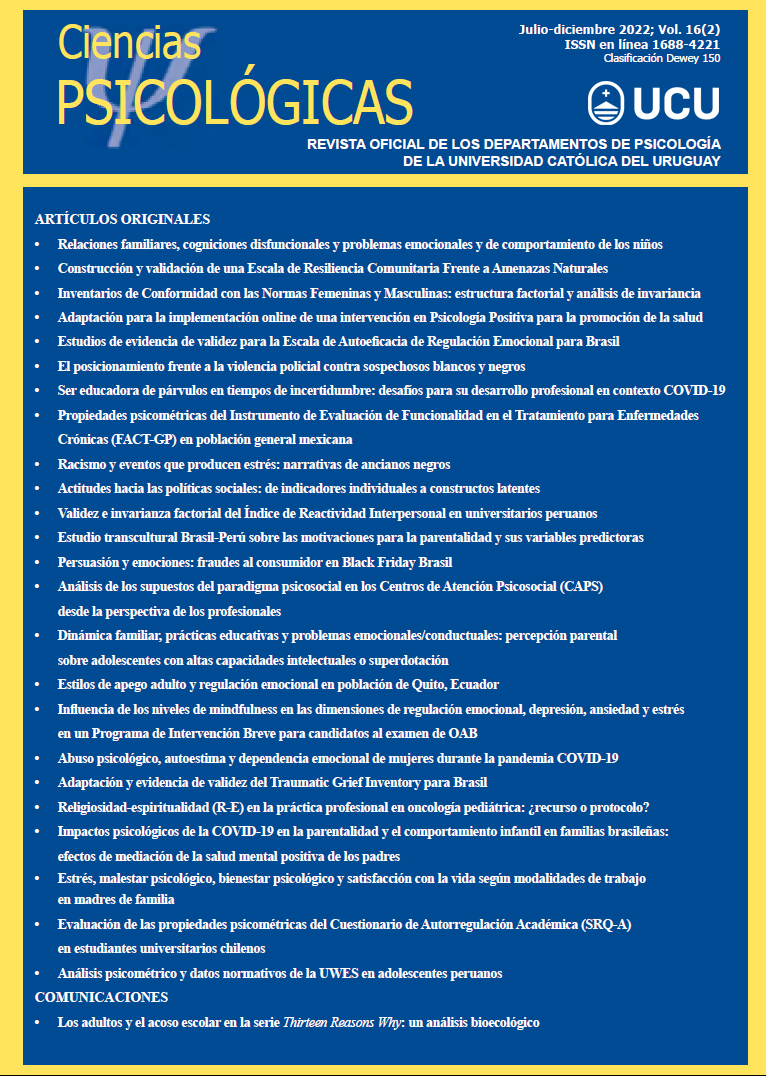Persuasion and emotions: consumer fraud on Black Friday Brazil
DOI:
https://doi.org/10.22235/cp.v16i2.2339Keywords:
Persuasion, Consumption, Twitter, Emociones, social mediaAbstract
This research aimed at analyzing the relation between emotions and consumer fraud, based on the Elaboration Likelihood Model (ELM). For this purpose, Sentiment Analysis was performed using the Natural Language Processing (NLP) from Twitter data obtained on the day of the event, and content analysis to understand the factors involved in the event and whether companies with reported complaints on PROCON/SP (2019) and the website Reclame Aqui (2019) were related. The results show that most emotions arising from Black Friday Brazil are both negative and related to consumer fraud. They also reveal that individuals who had low involvement with the persuasive messages used emotions as simple indications, unlike individuals who were highly involved and used emotions as an argument in the persuasive process to avoid being victims of fraud.
Downloads
References
Andrade, J., Hemzo, M. A., & Mazzon, J. A. (2011). Quatro décadas persuadindo leitores: uma aplicação do ELM no estudo do uso de rotas centrais e periféricas em anúncios impressos de veja. Revista de Investigación en Comunicación y Desarrollo, 2(2).
Ataman, F. & Özgüner, Ö. (2021). Determination of Social Media Users' Perceptions About “Black Friday” Activity via Sentiment Analysis. Educational Research (IJMCER), 3(3), 361-371.
Bardin, L. (1991). Análisis de contenido (Vol. 89). Akal.
Briñol, P., Petty, R. E., & Barden, J. (2007). Happiness versus sadness as a determinant of thought confidence in persuasion: A self-validation analysis. Journal of Personality and Social Psychology, 93(5), 711-727. https://doi.org/10.1037/0022-3514.93.5.711
Cacioppo, J. T., Petty, R. E., & Feng Kao, C. (1984). The Efficient Assessment of Need for Cognition. Journal of Personality Assessment, 48(3), 306-307. https://doi.org/10.1207/s15327752jpa4803_13
Castro, L. N. D. & Ferrari, D. G. (2016). Introdução à mineração de dados: conceitos básicos, algoritmos e aplicações. Saraiva.
De França, T. C. & Oliveira, J. (2014, August). Análise de sentimento de tweets relacionados aos protestos que ocorreram no Brasil entre junho e agosto de 2013 [Conferência]. III Brazilian Workshop on Social Network Analysis and Mining. Brasília, Brasil.
Festinger, L. (1950). Informal social communication. Psychological Review, 57(5), 271-282. https://doi.org/10.1037/h0056932
Festinger, L. (1954). A Theory of Social Comparison Processes. Human Relations, 7(2), 117-140. https://doi.org/10.1177/001872675400700202
Gomes, A., Santos, J. V. D., Gonçalves, G., Orgambidez-Ramos, A., & Giger, J. C. (2013). Estudo de validação da Escala de Necessidade de Cognição com amostra portuguesa. Avaliação Psicológica, 12(2), 179-192.
Hawkins, D. I. & Mothersbaugh, D. L. (2018). Comportamento do consumidor: construindo a estratégia de marketing. Elsevier Brasil.
https://sol.sbc.org.br/index.php/brasnam/article/view/6809/6702
Kamlot, D. (2012). Persuasão: a essência da propaganda. Revista Marketing, São Paulo, 3, 63-71.
Kang, Y., Cai, Z., Tan, C. W., Huang, Q., & Liu, H. (2020). Natural language processing (NLP) in management research: A literature review. Journal of Management Analytics, 7(2), 139-172.
Manguri, K. H., Ramadhan, R. N., & Amin, P. R. M. (2020). Twitter sentiment analysis on worldwide COVID-19 outbreaks. Kurdistan Journal of Applied Research, 54-65.
Muniz, K. M. & Maffezzolli, E. C. F. (2012). Persuasão em perspectiva: Elaboration Likelihooh Model e o Modelo de Abordagem Narrativa. Revista de Estudos da Comunicação, 13(31). http://dx.doi.org/10.7213/rec.v13i31.22402
Parodi, L. (2008). Manual das fraudes. Brasport.
Petty, R. E. & Briñol, P. (2014). Emotion and persuasion: Cognitive and meta-cognitive processes impact attitudes. Cognition and Emotion, 29(1), 1-26. https://doi.org/10.1080/02699931.2014.967183
Petty, R. E. & Cacioppo, J. T. (1981). Attitudes and persuasion. Classic and contemporary approaches. Brown.
Petty, R. E. & Cacioppo, J. T. (1984). The effects of involvement on responses to argument quantity and quality: Central and peripheral routes to persuasion. Journal of Personality and Social Psychology, 46(1), 69-81. https://doi.org/10.1037/0022-3514.46.1.69
Petty, R. E. & Cacioppo, J. T. (1986). The Elaboration Likelihood Model of Persuasion. Advances in Experimental Social Psychology, 123-205. https://doi.org/10.1016/s0065-2601(08)60214-2
Petty, R. E., Cacioppo, J. T., & Schumann, D. (1983). Central and peripheral routes to advertising effectiveness: the moderating role of involvement. Journal of Consumer Research, 10(2), 135. https://doi.org/10.1086/208954
Petty, R. E., Schumann, D. W., Richman, S. A., & Strathman, A. J. (1993). Positive mood and persuasion: Different roles for affect under high- and low-elaboration conditions. Journal of Personality and Social Psychology, 64(1), 5-20. https://doi.org/10.1037/0022-3514.64.1.5
Petty, R. E., Wells, G. L., & Brock, T. C. (1976). Distraction can enhance or reduce yielding to propaganda: Thought disruption versus effort justification. Journal of Personality and Social Psychology, 34(5), 874-884. https://doi.org/10.1037/0022-3514.34.5.874
Saura, J. R., Reyes-Menendez, A., & Palos-Sanchez, P. (2019). Are Black Friday deals worth it? Mining Twitter users’ sentiment and behavior response. Journal of Open Innovation: Technology, Market, and Complexity, 5(3), 58. https://doi.org/10.3390/joitmc5030058
Schwarz, N., Bless, H., & Bohner, G. (1991). Mood and persuasion: affective states influence the processing of persuasive communications. Advances in Experimental Social Psychology, 24, 161-199. https://doi.org/10.1016/s0065-2601(08)60329-9
Solomon, M. R. (2016). O Comportamento do consumidor: comprando, possuindo e sendo. Bookman.
Downloads
Published
How to Cite
Issue
Section
License
Copyright (c) 2022 Universidad Católica del Uruguay

This work is licensed under a Creative Commons Attribution 4.0 International License.
















